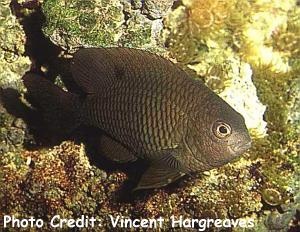
By Bob Goemans

Likely Reef Tank Suitable
Likely Fish-Only Tank Suitable
Range: Western Atlantic Ocean: Florida, Gulf of Mexico, the Caribbean, and south to Panama and Venezuela.
Size: 6 inches (15 cm)
Natural Environment: Inhabits rocky shores and tide pools at depths between 3 to about 10 feet (1– 3 m) where juveniles feed on zooplankton, and adults mainly feed on filamentous algae and somewhat on zooplankton.
General Husbandry: Rarely seen in the trade, with adults greyish black, and juveniles having reddish orange on the top of a dark silvery body, blue spots on the forehead and dark spots at the upper pectoral fin base, dorsal fin and caudal peduncle.
Best maintained in aquaria having live rock with growths of various forms of algae, hiding places, and somewhat aggressive tankmates, e.g., dottybacks, hawkfishes, large angelfishes and surgeonfishes.
As to diet, plant material (adults main food in the wild), e.g., flake foods, especially those containing Spirulina and Nori, combined with most regular aquarium foods, e.g., live fortified brine shrimp and/or finely chopped various frozen or fresh meaty foods such as mysis, squid, fish flesh, shrimp, clam, etc., which would be mainly for juveniles, should be offered once or twice daily.
Taxonomy:
Order: Perciformes
Suborder: Labroidei
Family: Pomacentridae
Subfamily: Pomacentrinae
Genus: Stegastes
FYI: One per aquarium, unless being maintained in large aquariums, >75 gallons.
Highly territorial.
Experience Level: Intermediate
Temperament: Aggressive
Diet: Omnivore
Coral Safe: Yes
Invertebrate Safe: With caution
Acclimation Time: 30 minutes+
Aquarium Environment: Reef or fish-only aquarium
Tankmates: Aggressive
Minimum Tank Size: 75 gallons
Temperature Range: 74 - 84°F (23 – 28°C)
Specific Gravity: 1.020 - 1.026
pH: 8.0 - 8.5
